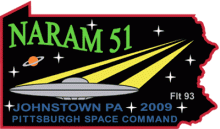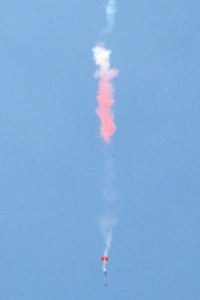
|
NARAM-51
Event Tips Pages
(draft)
|

|
Random Altitude
For NARAM-51, a version of Precision Altitude, named
Random Altitude is being held.
Random Altitude has the challenge of building and flying a
model that can fly as close as possible, to a Target Altitude which
is not announced until shortly before the event is held.
Only one flight is allowed. If the track is lost, does not
close, or if there is a Cato, a reflight will be allowed.
The Target Altitude will be Randomly chosen at the field on
Tuesday morning, the day of the event.
Engine power - Anything up to 160 N-Seconds total (G
class), with Contest Certified engines.
The model can not be radio controlled or contain any device whose
purpose is to limit the altitude of the model (e.g., a wire or
string).
For the full rules for this event, please see the Precision
Altitude Rules on the NAR web page. Take note that Random
Altitude is listed in rule 22.2.3
Scoring - For Random Altitude, the Model's tracked Altitude
is calculated against the Target Altitude to produce a percentage
error. Lowest percentage error wins.
For example, let's say the Target Altitude chosen for the day was
200 meters. If one model flies to 180 meters, and another model flies
to 220 meters, both being 20 meters off from the target of 200, both
would get a score of 10%. A model that flies to 196 meters, or to 204
meters would get a 2% error. Remember that the 200 meter target
altitude is ONLY an example here.
Design considerations - It is not practical to produce a
list of plans or kits, since this is so wide open. You certainly do
not have to build a special model for this event, you can make use of
an existing sport model if you want. The trick is in trying to make
it fly as close to the Target Altitude as possible.
Strategies - I believe this is the first time this event
has been flown at a NARAM. It almost defies a strategy.
If this was Predicted Altitude, you could just test or practice
fly your model at some other launch, get it tracked (or use an
altimeter), and use the altitude it flew to as your prediction.
If this was Set Altitude (Target altitude announced with the
contest info), then the first step would be to use computer Flight
Simulation software. The Flight Sim would give you a ballpark idea
how high various rockets would fly with different engines, choose a
combination that would fly close to the "Set" target altitude, and
test fly it. You could test it at a launch, find out how high it went
(tracked or altimeter), then make adjustments such as adding some
extra mass to make it fly lower, or even changing to a different
model that could fly higher.
But for Random Altitude, you cannot prepare very much in advance
like above, since the Target Altitude will not be known until the
morning the event is held.
If you do have any models that you know how high they fly, great,
take them. If you are lucky, the Target altitude might happen to be
close to an altitude you know those models fly.
If not, it pretty much comes down to computer flight simulations.
If you can bring a laptop to the field, that would help, but that may
not be very practical for most people.
But, there definitely will be some who will bring laptops to the
field for this very reason, to run flight sims once the target
altitude is known. Those who are well prepared will bring an
assortment of rockets, so that if the Target Altitude is too much
mid-way between what a certain rocket would fly on a B or a C engine,
they will have several different rockets that would fly to different
altitudes on a given engine. For example, one rocket that would fly
to 189 meters on a B, another to 228 meters on a B, another would fly
to 264 meters on a B. So they could choose the appropriate one to
work on adjusting from (By using one that is known to fly higher than
the Target Altitude and add some mass to make it fly lower, with
Flight Sim software to help indicate how much).
So, at the least, bring a variety of rockets and engines. If you
do have flight sims, but cannot bring a laptop, then run the sims at
home and make a record of how high the models should fly for a given
engine and given mass. Make some runs with some extra mass, to se the
effect on the altitude, and include that in the records you keep. So,
you will have some idea to work with.
Now, unfortunately, flight sims and real world altitudes do not
tend to be the same. So, if your flight sim says your model should
fly to 202 meters, and if the Target Altitude was announced as 200
meters, do not do the victory dance just yet. It might turn out that
the flight sim is wrong. In general, flight sims tend to
over-estimate the altitude. So, if a flight sim said 202 meters, I
would not be surprised for the real altitude to be tracked to 183
meters, or something like that.
Also, keep in mind that the tracking is at EJECTION, not apogee.
So for flight sims, use the option to tell you the altitude at
ejection, not at apogee.
Last tip - ASK! If you have no better idea, you can ask some
fellow competitors for help. Someone might have a decent idea of how
high a rocket like yours is likely to go on a given engine.
Especially if you have a rocket that is a fairly popular model for
the event since many people will tend to use kits for this.
Some additional advice from other competitors:
|
From Greg Poehlein:
The only thing I can think of is pretty obvious - build a
payload model and fly it several times on each motor with no
weight in the payload section and then with a couple other
known weights. Given three or four data points for each
motor, you should be able to guestimate the amount of weight
needed in the payload section to get the required altitude.
Of course, that means a number of test flights with full
tracking, but I suppose even an Estes Altitrack would be
better than nothing at all.
|
|
Excerpts from Lee James, from the TCC
NAR Competition Primer page for Precision
Altitude:
Almost any kit and contest approved motor will work.
Use computer simulations to determine altitude for
various rocket and motor combinations. Free altitude
simulation:
wRASP - http://www.wrasp.com/
wRASP 32 - http://tccnar.tripod.com/sims/082_wRASP32_221.zip
Make multiple flights with various models and motors
using NAR competition type theodolites ( USMRSC 14 Altitude
Data ) to determine the altitude your model achieves. Add
weight, such as tracking powder, and/or use a different
motor to reach the altitude you want. Make practice flights
using theodolites to measure altitude and/or computer
simulation to find how much weight to add and/or which motor
to use.
You can use tracking powder to vary the launch weight of
your entry, but its main purpose is to make the model more
visible to the trackers (theodolite operators). Chalk for a
carpenter's chalk line is available at most hardware stores.
For more info on tracking powder see rmr FAQ part
9.4.i.1:
http://www.ninfinger.org/~sven/rockets/rmrfaq.9.html
|
|
Tracking Powder - It is highly recommended to use
tracking powder in your model. This produces a small "cloud"
at ejection which the tracking crew looks for. Without
tracking powder, it is not likely your model will get
tracked.
Dry Tempera paint, or a fine powdered Fluorescent Dye,
are often used for tracking powder. Some contestants used to
rely on powdered chalk, but it is clumpy and does not really
produce much of a tracking cloud for the volume/weight of
the powder. Red is a good color choice for tracking powder,
though some like to use black if there is a high overcast or
hazy "white" sky. Fellow competitors are often willing to
share tracking powder.
Here's a good way to install tracking powder. After
installing wadding, pack the parachute and shock cord into
the model, and push them down into the tube to leave room
for the tracking powder in the upper part of the tube. Use a
piece of wadding or plain paper to make up a long narrow
"cup" than will easily slide inside the body tube. Press
that cup into the tube, then pour in the tracking powder to
fill the cup. About 1" or so depth of powder is a good
ballpark. Using tracking powder can require greater forces
to expel everything out of the body, which sometimes results
in the engine kicking out instead (however, the cup method
reduces this problem a bit compared to just dumping powder
into the tube). Make sure the engine is secured in the
rocket extra-tight. Some people like to attach the fins a
bit above the bottom of the body tube so they can apply a
"collar" wrap of tape to the bottom of the tube and the
engine. This helps prevent the engine from ejecting.
|

click on thumbnail
|
|
Above: Example of a tracking
powder cloud, using Red powder, on a B Eggloft
Flight.
|
|
|
return to top
Last Updated 7/3/2009


